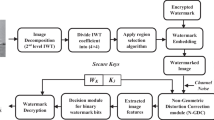Abstract
Data hiding is a technique that embeds a cluster of secret messages into the original image. The image with secret messages can be distributed on the Internet while the message embedded would not be easily discovered by a third party. In this way, the secret message can be well protected. At the same time, an image might be made with complex and smooth textures. If changes are made on complex textures, it is less easy for human eyes to discern the differences in the image; but if changes are made on smooth textures, the changes are easier to be discerned by human eyes. This paper proposes a data hiding method based on reduplicated exploiting modification direction (REMD), image interpolation, and canny edge detection. It aims at fulfilling two goals. First, conduct difference-embedding on the image’s feature information, distribute the image, and use image interpolation to accomplish reversibility. Second, check the pixels that are located at the edge and insert different data payload according to the application demands. This allows users to flexibly adjust data payload embedded into the image’s edge pixels according to their practical conditions, effectively considering both the image quality and payload. The experimental results demonstrate that the proposed method can achieve the data payload of 3.01bpp, so this is a reversible hiding technique with a very high embedding capacity. In the mean time, the average image quality is kept at an acceptable level, about 33 ± 1 dB.







Similar content being viewed by others
References
Allebach J, Wong PW (1996) Edge-directed interpolation. Proceedings of IEEE International Conference on Image Processing:707–710
Chan CK, Cheng LM (2004) Hiding data in images by simple LSB substitution. J Pattern Recognit 37(3):469–474
Chang YT, Huang CT, Lee CF, Wang SJ (2013) Image Interpolating based data hiding in conjunction with pixel-shifting of histogram. J Supercomput 66(2):1093–1110
Chang CC, Kieu D, Chou YC (2007) Reversible data hiding scheme using two steganographic images. Proceedings of 2007 I.E. TENCON:1–4
Chen WJ, Chang CC, Hoang Ngan Le T (2010) High payload steganography mechanism using hybrid edge detector. Expert Syst Appl 37(4):3292–3301
Jensen K, Anastassiou D (1995) Subpixel edge localization and the interpolation of still images. IEEE Trans Image Process 4:285–295
Jung KH, Yoo KY (2009) Data hiding method using image interpolation. Comput Stand Interfaces 31(2):465–470
Kuo WC, Hsu WT (2010) Reversible data hiding scheme based on EMD method. Proceedings of 2010 Taiwan Academic Network Conference (in Chinese version)
Lee CF, Chang CC, Pai PY, Liu CM (2015) Adjustment hiding method based on exploiting modification direction. Int J Netw Secur 17(5):607–618
Lee CF, Chuang LY, Chang CC (2008) Hiding information employing reduplicating embedding. Proceedings of 2008 I.E. Asia-Pacific Services Computing Conference:825–828
Lee CF, Huang YL (2012) An efficient image interpolation increasing payload in reversible data hiding. Expert Syst Appl 39(8):6712–6719
Lehmann TM, Gonner C, Spitzer K (1999) Survey: interpolation methods in medical image processing. IEEE Trans Med Imaging 18(11):1049–1075
Li X, Orchard MT (2001) New Edge-Directed Interpolation. IEEE Trans Image Process 10(10):1521–1527
Qin C, Chang CC, Chiu YP A novel joint data-hiding and compression scheme based on SMVQ and image inpainting. IEEE Trans Image Process 23(3):696–978
Qin C, Chang CC, Hsu TJ (2015) Reversible data hiding scheme based on exploiting modification direction with two steganographic images. Multimed Tools Appl 74(15):5861–5872
Qin C, Zhang XP (2015) Effective reversible data hiding in encrypted image with privacy protection for image content. J Vis Commun Image Represent 31:154–164
Shen SY, Huang LH (2015) A data hiding scheme using pixel value differencing and improving exploiting modification directions. Comput Secur 48:131–141
Sun HM, Weng CY, Wang SJ, Yang CH (2013) Data embedding in image-media using weight-function on modulo operation. ACM Trans Embed Comput Syst 12:21:1–21:10
Unser M, Aldroubi A, Eden M (1995) Enlargement or reduction of digital images with minimum loss of information. IEEE Trans Image Process 4(3):247–258
Zhang XP (2013) Reversible data hiding with optimal value transfer. IEEE Trans Multimed 15(2):316–325
Zhang X, Wang S (2006) Efficient steganographic embedding by exploiting modification direction. IEEE Commun Lett 10:781–783
Zhang X, Wang S (2006) Efficient steganographic embedding by exploiting modification direction. IEEE Commun Lett 11(10):781–783
Acknowledgments
This work was supported in part by the Ministry of Science and Technology, Taiwan, under Contract MOST 104-2221-E-324-013.
Author information
Authors and Affiliations
Corresponding author
Rights and permissions
About this article
Cite this article
Lee, CF., Weng, CY. & Chen, KC. An efficient reversible data hiding with reduplicated exploiting modification direction using image interpolation and edge detection. Multimed Tools Appl 76, 9993–10016 (2017). https://doi.org/10.1007/s11042-016-3591-z
Received:
Revised:
Accepted:
Published:
Issue Date:
DOI: https://doi.org/10.1007/s11042-016-3591-z




